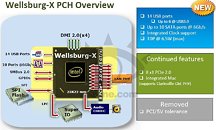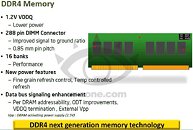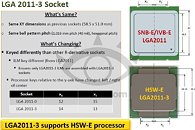Sunday, June 16th 2013

Haswell-E - Intel's First 8 Core Desktop Processor Exposed
Another day, another Intel leak and a few surprises as well. During the last few days we covered Intel's desktop roadmap for the next twelve months, bringing you news and insights on Intel's plans for the aforementioned time interval. Today we bring you news on what's to follow in the second half of 2014, specifically, on Intel's Premium Desktop plans for the interval, namely Haswell-E, DDR4 and the X99 PCH.
Haswell-E will be Intel's last and best offering using the 22 nm fabrication process, it will come in two versions, core count wise, 8 core part(s) as well as 6 core part(s) with hyper-threading enabled, therefore, boasting no less that 16 execution threads for the 8 core chips and 12 execution threads for the 6 core version(s). Judging by that alone, Haswell-E should constitute a far superior upgrade over Ivy Bridge-E, compared to what the latter will be in relation to Sandy Bridge-E, Haswell-E offering two additional physical cores that translate into four additional execution threads. The new chips will boast 2.5 MB of L3 Cache per core, summing up to 20 MB total L3 cache for the 8 core parts. TDP will remain in the same neighborhood it was in the case of its predecessors, around 130-140 W.Haswell-E will of course be accompanied by a new platform, dubbed Wellsburg, the X99 chipset will bring a host of new features, the most important one being quad channel DDR4 support. With four basic frequency settings, starting at 1333 MHz and moving up in increments of 266 MHz to a maximum of 2133 MHz, at which point overclocking should be employed to attain superior clocks. However we sincerely doubt that any DDR4 modules/kits, clocked below 2133 MHz, will be made available for this platform. Modestly clocked (1333 MHz), low voltage (1.2 V) kits are supported by the new platform as well. The DIMM connector was also modified to support Non Volatile DIMMs, receiving four more pins for the purpose (288 instead of 284), modification that will not negatively impact compatibility with 284 pin modules in any way.
Other points of interest regarding the X99 chipset are:
Given the information at hand, trying to quantify performance gains, speculate on overclocking potential and other such conclusory attempts to wrap up the above presented information, I admit is quite enticing and intriguing, but I'll end here and outsource the pleasure of doing that to you.
Post Scriptum
A big hand for radrok, for bringing this to my attention.
Source:
VR Zone
Haswell-E will be Intel's last and best offering using the 22 nm fabrication process, it will come in two versions, core count wise, 8 core part(s) as well as 6 core part(s) with hyper-threading enabled, therefore, boasting no less that 16 execution threads for the 8 core chips and 12 execution threads for the 6 core version(s). Judging by that alone, Haswell-E should constitute a far superior upgrade over Ivy Bridge-E, compared to what the latter will be in relation to Sandy Bridge-E, Haswell-E offering two additional physical cores that translate into four additional execution threads. The new chips will boast 2.5 MB of L3 Cache per core, summing up to 20 MB total L3 cache for the 8 core parts. TDP will remain in the same neighborhood it was in the case of its predecessors, around 130-140 W.Haswell-E will of course be accompanied by a new platform, dubbed Wellsburg, the X99 chipset will bring a host of new features, the most important one being quad channel DDR4 support. With four basic frequency settings, starting at 1333 MHz and moving up in increments of 266 MHz to a maximum of 2133 MHz, at which point overclocking should be employed to attain superior clocks. However we sincerely doubt that any DDR4 modules/kits, clocked below 2133 MHz, will be made available for this platform. Modestly clocked (1333 MHz), low voltage (1.2 V) kits are supported by the new platform as well. The DIMM connector was also modified to support Non Volatile DIMMs, receiving four more pins for the purpose (288 instead of 284), modification that will not negatively impact compatibility with 284 pin modules in any way.
Other points of interest regarding the X99 chipset are:
- Up to six USB 3.0 ports
- Up to eight USB 2.0 ports
- Up to ten SATA 6 Gbps ports
- Integrated Clock support
- TDP of 6.5W
Given the information at hand, trying to quantify performance gains, speculate on overclocking potential and other such conclusory attempts to wrap up the above presented information, I admit is quite enticing and intriguing, but I'll end here and outsource the pleasure of doing that to you.
Post Scriptum
A big hand for radrok, for bringing this to my attention.




77 Comments on Haswell-E - Intel's First 8 Core Desktop Processor Exposed
Still no Thunderbolt? Come on Intel, you're going to let it go the way of firewire.
Although it would be nice to have 16threads at 4.6ghz or something like that, but i know cpu price will be "nice" too 600-800€ + if not more for sure :S
And Intel said they are using a Tick-Tock roadmap, with a major update requiring a new platform and then a minor one that doesn't. So this is the way forward with them.
To me Intel is just making it confusing with all these new sockets, but that's just me.
I can under stand I guess with this new 8 core as its intels first and all, but i just don't get it with socket 1150, that socket is going to be very short lived?
If the mainstream will look like this:
4 Cores on:
Celeron & Pentium 4 Cores / i3 4 Cores, 8 Threads
6 Cores on:
i5 6 Cores / i7 6 Cores, 12 Threads
This would be very nice just my thought, so that the new LGA 2011-3 to have a minimum of 6 Cores, 12 Threads. another good thing is TDP to be 84W < and below in relevance to CPU on the mainstream side and the Price to remain same for mainstream and performance.
long live AMD
i went from an am2 motherboard to am2+ to AM3+ with the SAME CPU XD
I did realize there have been 8 core CPU's from intel in the past called umm I cant remember started with a D? but it wasn't for desktop/main stream so never worried about it.Which socket do you mean? the one that already supports 8-core processors? 1155?
more boards bought = more revenue from manufacturers! win for everyone!
If you don't want to pay for it, no-one's going to be forcing you to upgrade, so there...
Anyway the current X79 platform sucks, the sooner they kill that off the better. Maybe Haswell-e will save the highend.
Actually you can > www.gigabyte.com/products/product-page.aspx?pid=3581#
It might not support BD or PD but it supports everything else. And those CPU's can also be used in socket AM3+ Thats a pretty wide range. You wont find that support from intel anywhere.
I get what you mean but the support is there one way or another if its an old mobo with a new upgrade to CPU or then if you want to have the use of USB3 etc you can still use your CPU from your AM2 mobo and put it into an AM3+ mobo, you don't have to buy two parts every time you wish to upgrade, you know what i mean?So you mean server CPU's?? not desktop? and if that's the case why do they need a new socket then for this new 8-core desktop CPU's? :confused: Ok yes for DDR4 but that's just silly.That might be ok for you but when you have spent alot of money on a top end mobo with all the bells and whissels on it (FYI AMD has had those features for yrs now 6GB/s ports and plenty of USB3 ports) I for one wouldn't like to dish out another 200-300$ just so I can support a new CPU each or next year. $500-600 for what 8 core processor? if you think this one from intel will be that cheap you best think again.